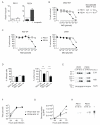RAD51 and BRCA2 Enhance Oncolytic Adenovirus Type 5 Activity in Ovarian Cancer
- PMID: 26452665
- PMCID: PMC4716290
- DOI: 10.1158/1541-7786.MCR-15-0188-T
RAD51 and BRCA2 Enhance Oncolytic Adenovirus Type 5 Activity in Ovarian Cancer
Abstract
Homologous recombination (HR) function is critically important in high-grade serous ovarian cancer (HGSOC). HGSOC with intact HR has a worse prognosis and is less likely to respond to platinum chemotherapy and PARP inhibitors. Oncolytic adenovirus, a novel therapy for human malignancies, stimulates a potent DNA damage response that influences overall antitumor activity. Here, the importance of HR was investigated by determining the efficacy of adenovirus type 5 (Ad5) vectors in ovarian cancer. Using matched BRCA2-mutant and wild-type HGSOC cells, it was demonstrated that intact HR function promotes viral DNA replication and augments overall efficacy, without influencing viral DNA processing. These data were confirmed in a wider panel of HR competent and defective ovarian cancer lines. Mechanistically, both BRCA2 and RAD51 localize to viral replication centers within the infected cell nucleus and that RAD51 localization occurs independently of BRCA2. In addition, a direct interaction was identified between RAD51 and adenovirus E2 DNA binding protein. Finally, using functional assays of HR competence, despite inducing degradation of MRE11, Ad5 infection does not alter cellular ability to repair DNA double-strand break damage via HR. These data reveal that Ad5 redistributes critical HR components to viral replication centers and enhances cytotoxicity.
Implications: Oncolytic adenoviral therapy may be most clinically relevant in tumors with intact HR function.
©2015 American Association for Cancer Research.
Figures






References
-
- Mukhopadhyay A, Plummer ER, Elattar A, Soohoo S, Uzir B, Quinn JE, et al. Clinicopathological Features of Homologous Recombination-Deficient Epithelial Ovarian Cancers: Sensitivity to PARP Inhibitors, Platinum, and Survival. Cancer Res. 2012;72:5675–82. - PubMed
-
- McNeish I, Coleman RL, Oza A, Konecny G, O'Malley DM, Kichenadasse G, et al. Updated Results of Ariel2, a Phase 2 Open-Label Study to Identify Ovarian Cancer Patients Likely to Respond to Rucaparib. International Journal of Gynecological Cancer. 2014;24:323–4.
Publication types
MeSH terms
Substances
Grants and funding
LinkOut - more resources
Full Text Sources
Other Literature Sources
Medical
Research Materials
Miscellaneous

